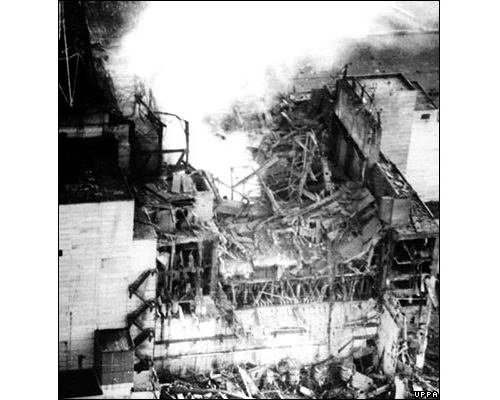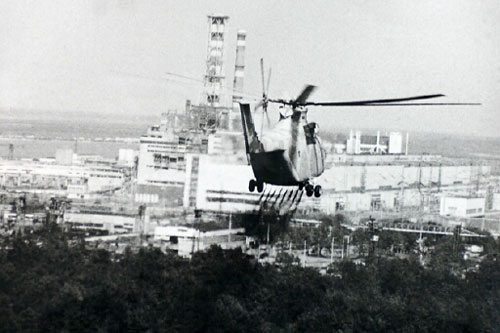Ukraine, 1986: the world’s most devastating nuclear accident
April 26, 1986 : The scale of the Chernobyl disaster that occurred in Ukraine, took the Soviet authorities by surprise. The urgency imposed dramatic conditions, but the habit of secrecy, the habit also to not be held accountable, made these authorities to hid 36 hours the nature of the accident.
The Chernobyl nuclear reactor belonged to the RBMK class, a common type of reactor developped in the USSR and the Eastern Europe countries after the war. RBMKs burned slightly enriched uranium, have graphite moderators and used water as a coolant. RBMK reactors had known weaknesses. In particular, they may be become unstable at low power. The RBMK reactors suffered from an additional weakness – it took too long to insert the control rods into the reactor (28s as opposed to 1s for Western-style reactors), thus making the instabilities harder to overcome.
These weaknesses were nevertheless not the primary cause of the disaster. Operators inadvertently deactivated safety systems during a low power test while the reactor was unstable. Therefore, Chernobyl remains the only accident where control of nuclear fission was lost.

An explosion followed by an intense fire
The violent explosion that lifted the heavy slab covering the reactor was followed by an intense fire fed by the large amount of graphite present in the reactor core. Extinguishing the fire, lasted several days. Then, steam continyd to escape from the still smoking ruins. The radioactive releases due to the explosion and the fire are at the origin of the Chernobyl cloud.
© UPPA/BBC News 1986
On the 26th of April 1986, after several errors of judgement were made during an attempt to improve security, a reactor at the Chernobyl power plant exploded. The team in charge of the reactor had hoped to test what would happen if the security system were to fail, and the nuclear fuel to cool down. In order to do this, they tried to conduct the test with the reactor turned off.
The reactor was then operated at levels forbidden by the safety guidelines, with the security systems temporarily disabled. It took six major human errors for the disaster to occur.
A violent explosion lifted the heavy slab covering the reactor. Then the large amount of graphite which served to moderate the neutrons caught fire. It took several days to tackle the fire in extreme conditions, a deadly radioactivity adding to the hell of fire. From the core of the disembowelled reactor, left bare, escaped large amounts of radioactive material.

Flying over the destroyed reactor:
A helicopter flies over the Chernobyl site in the week following the accident to allow experts to gauge the damage caused to the reactor.
© Ukrainian Society for Friendship and Cultural Relations with Foreign Countries
The absence of a security system made the situation far worse. Approximately 4% of the radioactive substances contained in the reactor were released into the atmosphere; including almost 50% of the caesium and iodine content and 100% of the xenon. The resulting radioactive cloud rose to some 10,000 metres above sea level and was spread westward by the winds over several million square kilometres, most severely affecting the northern Ukraine. At the moment of the disaster, 46% of the radiation emitted by the cloud was due to iodine 131, 36% was caused by tellurium 132, 7% by barium 140, 4% by caesium 137 and 2% by caesium 134. The presence of caesium 134 was one of the most important signatures of the Chernobyl accident. This fission product beeing shortlived, it was an extinct isotope never found in the fallout from atomic bombs.
For the 273,000 people living in close proximity to the power plant, the average dose of radiation absorbed over the following three years was 35 millisievert or mSv, with some having absorbed as much as 200mSv. The average Western European dose, by comparison, was between 0.05 and 0.5 mSv; a dose that pales into insignificance when one remembers that natural radioactivity exposes us to around 2.4m Sv a year. We in the West tend to forget that the shadow of Chernobyl falls primarily on the Ukraine, Belarus and Russia; the countries that have most suffered, and continue to suffer, from the disaster.
or mSv, with some having absorbed as much as 200mSv. The average Western European dose, by comparison, was between 0.05 and 0.5 mSv; a dose that pales into insignificance when one remembers that natural radioactivity exposes us to around 2.4m Sv a year. We in the West tend to forget that the shadow of Chernobyl falls primarily on the Ukraine, Belarus and Russia; the countries that have most suffered, and continue to suffer, from the disaster.
Articles on the subject « Chernobyl accident »
Chernobyl Circumstances
An explosion followed by a graphite fire In 1986 the Ukrainian Chernobyl plant had 4 RBMK reactor[...]
Chernobyl Liquidators
A heavy toll paid by firefighters and liquidators: The magnitude of the disaster took the Soviet [...]
Radioactive Releases
Radioactive releases and contaminations at Chernobyl The explosion of the reactor led to the disp[...]
Chernobyl Plume
A deep mark in the french collective unconscious « The Chernobyl cloud has stopped at the french [...]
Chernobyl Exclusion Zone
A no man’s land turned into a natural reserve ? On April 27th, 1986, one day after the expl[...]
Chernobyl Health Effects
Chernobyl: A toll still impossible to quantify It is difficult to reach an approached assessment [...]
Chernobyl Iodine 131
A dangerous radioelement during the first weeks Iodine-131 is the most feared fission product whe[...]
Chernobyl Caesium-137
The accident long term legacy More than twenty years after the Chernobyl accident, attention focu[...]
Chernobyl Today
The Chernobyl Site Over 30 Years Later On December 15, 2000, the Ukrainian government, in accorda[...]